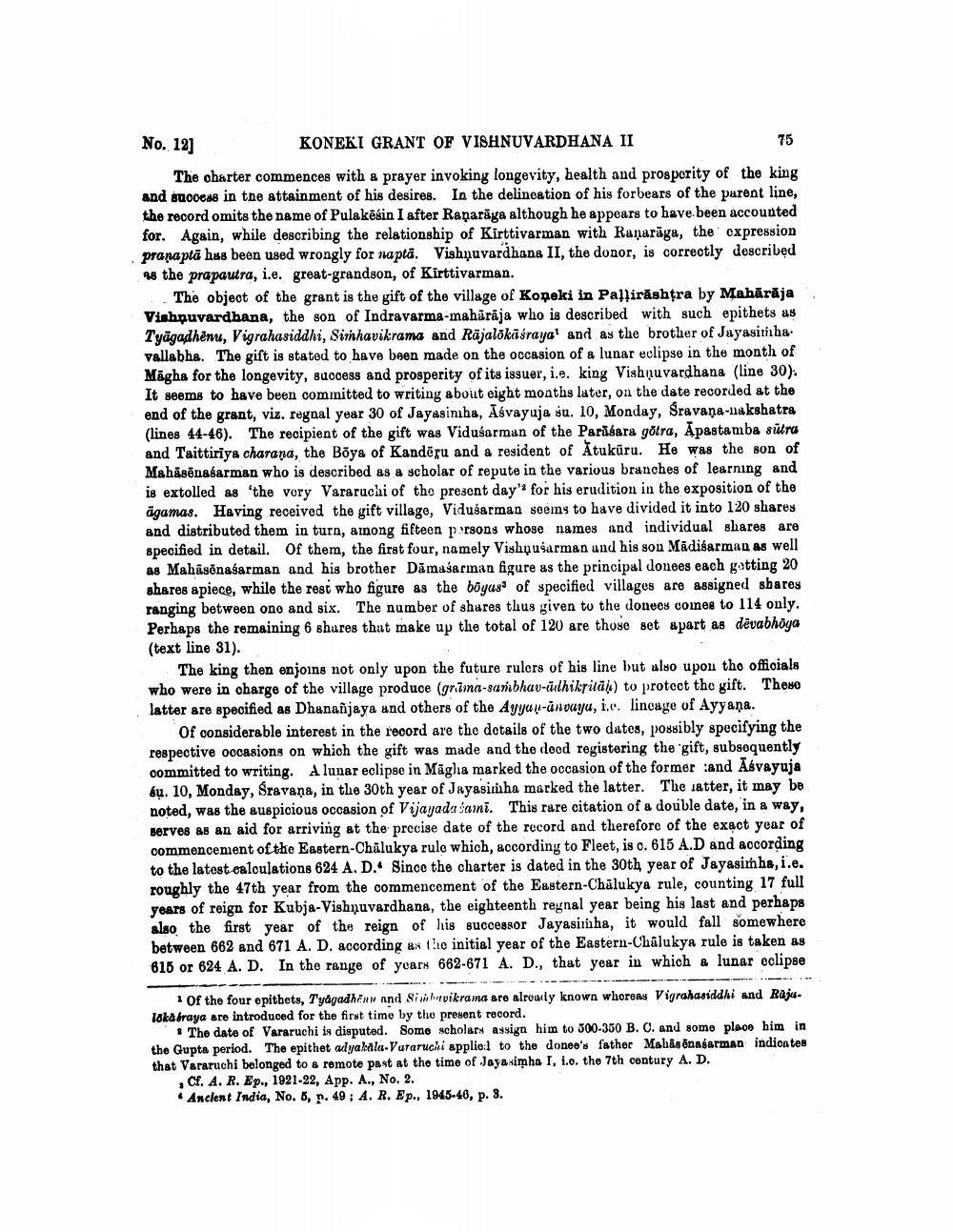________________
No. 12] KONEKI GRANT OF VISHNUVARDHANA II
75 The charter commences with a prayer invoking longevity, health and prosperity of the king and sucocus in the attainment of his desires. In the delineation of his forbears of the parent line, the record omits the name of Pulakēsin I after Raņarāya although he appears to have been accounted for. Again, while describing the relationship of Kirttivarman with Ranarūga, the expression pranaptā has been used wrongly for naptá. Vishņuvardhana II, the donor, is correctly described 48 the prapautra, i.e. great-grandson, of Kirttivarman.
The objeot of the grant is the gift of the village of Kopeki in Pallirashtra by Mahārāja Vishnuvardhana, the son of Indravarma-mahārāja who is described with such epithets as Tyāgadhenu, Vigrahasiddhi, Sinhavikrama and Rājalokasrayal and as the brother of Jayasinha vallabha. The gift is stated to have been made on the occasion of a lunar eclipse in the month of Mägha for the longevity, success and prosperity of its issuer, i.e. king Vishnuvardhana (line 30). It seems to have been committed to writing about eight months later, on the date recorded at the end of the grant, viz. regnal year 30 of Jayasinha, Āśvayuja su. 10, Monday, Sravana-nakshatra (lines 44-46). The recipient of the gift was Vidušarman of the Parūsara götra, Apastamba sülra and Taittiriya charana, the Böya of Kandēru and a resident of Atukūru. He was the son of Mahāsēnabarman who is described as a scholar of repute in the various branches of learning and is extolled as 'the vory Vararuchi of the present day' for his erudition in the exposition of the agamas. Having received the gift villago, Vidušarman seems to have divided it into 120 shares and distributed them in turn, among fifteen persons whose names and individual shares are specified in detail. Of them, the first four, namely Vishnusarman und his son Mādisarman as well as Mahāsēnaśarman and his brother Dāmasarıan figure as the principal donees each gatting 20 shares apiece, while the rest who figure as the boyas' of specified villages are assigned sbares ranging between ono and six. The number of shares thus given to the donees coines to 114 only. Perhaps the remaining 6 shures that make up the total of 120 are those set apart as devabhöga (text line 31).
The king then enjoins not only upon the future rulers of his line but also upon the officials who were in charge of the village produce (grina-sanibhav-ühikrital) to protect the gift. These latter are specified as Dhanañjaya and others of the Ayya w-ūnvuyu, i.c. lincage of Ayyaņa.
Of considerable interest in the record are the details of the two dates, possibly specifying the respective occasions on which the gift was made and the deed registering the gift, subsequently committed to writing. A lunar eclipse in Māgha marked the occasion of the former and Aśvayuja bu. 10, Monday, Sravana, in the 30th year of Jayasitisha marked the latter. The latter, it may be noted, was the auspicious occasion of Vijayadasani. This rare citation of a double date, in a way, serves as an aid for arriving at the precise date of the record and therefore of the exact year of commencement of the Eastern-Chalukya rule which, according to Fleet, is o. 615 A.D and according to the latest calculations 624 A. D.. Since the charter is dated in the 30th year of Jayasirha, i.e. roughly the 47th year from the commencement of the Eastern-Chālukya rule, counting 17 full years of reign for Kubja-Vishnuvardhana, the eighteenth reynal year being his last and perhaps also the first year of the reign of his successor Jayasimha, it would fall somewhere between 662 and 671 A. D. according as the initial year of the Eastern-Chalukya rule is taken as 616 or 624 A. D. In the range of years 662-671 A. D., that year in which a lunar eclipse
of the four opithets, Tyagadhon and Sivikrama are alroudly known whorens Vigrahasiddhi and Raju. lokasraya are introduced for the first time by the present record.
# The date of Vararuchi is disputed. Somo scholars assign him to 300-350 B. C. and some place him in the Gupta period. The epithet adyalla-Vararucli applie:l to the doneo's father Mabās ēnasarman indicates that Vararuchi belonged to a remote past at the time of Jaya zimha I, i.e. the 7th century A. D.
C. A. R. Ep., 1921-22, App. A., No. 2. Ancient India, No. 6, p. 49; A. R. Ep., 1945-40, p. 8.




